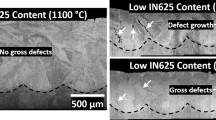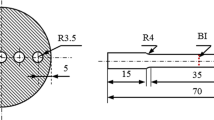Abstract
Eutectic bonding is a technique commonly used in the electronics industry to fasten silicon chips to substrates coated with gold. The reverse process of bonding small gold tabs to large semiconductor substrates is also possible. Gold plated Kovar tabs have been bonded to a hot pressed silicon-germanium alloy (80 wt % Si) and to single crystals of silicon and germanium. The joining alloys used were gold-silicon (2 wt % Si) and gold-germanium (22 wt % Ge) which melt at 370‡C and 356‡C, respectively. Ultimate tensile loads have been measured and found to range from approximately 7.5 to l8 kilograms. Low tensile loads were associated with semiconductor surfaces which showed little evidence of dissolution, apparently protected by a surface oxide. A preliminary etch in 10% HF increased failure load considerably. Fracture then took place within the semiconductor material. Low strength bonds exhibit a lamellar eutectic structure, while high strength bonds exhibit lace-like grain boundary penetration of gold. Bonds on single crystals have considerable microstructural detail. Some show evidence of dendritic solidification, while others show evidence of eutectic solidification.
Similar content being viewed by others
References
W. E. Kohl, Handbook of Materials and Techniques for Vacuum Devices, p. 377, Reinhold Publishing Corporation, New York (1967).
L. Bernstein, Semiconductor Products, 4, No. 7, 29, (1961).
L. Bernstein Semiconductor Products, 4, No. 8, 35, (1961).
M. H. Williamson, Proceedings of the Fourth Annual Microelectronics Symposium, “Molecular Concepts in Microelectronics,≓ I.E.E.E. publication, p. 6A-1 (1965).
J. A. Borders and J. N. Sweet, J. Appl. Phys., 43, 3803, (1972).
P. Lukes, Surface Science, 30, 91, (1972).
R. E. Oakley and G. A. Godber, Thin Solid Films, 9, 287, (1972).
F. P. Fehlner, J. Electrochem. Soc., 119, 1723, (1972).
W. Mehl, H. F. Gossenberger and E. Helpert, J. Electro-chem. Soc., 110, 239, (1963).
R. C. Dorward and J. S. Kirkaldy, J. Electrochem. Soc., 116, 1284, (1969).
J. I. Pankove, J. Appl. Phys., 28, 1054, (1957).
G. A. Chadwick, Solidification, p. 99, American Society for Metals, Metals Park, Ohio, (1971).
M. E. Glicksman,, American Society for Metals, Metals Park, Ohio, p. 155, 1971.
R. D. Nasby, Sandia Laboratories Progress Report, SC-PR-72-0258, 21, (1972).
R. S. Wagner and W. C. Ellis, Trans. A.I.M.E., 233, 1053, (1965).
E. Philofsky, R. V. Ravi, J. Brooks, and E. Hall, J. Electrochem. Soc., 119, 527, (1972).
Author information
Authors and Affiliations
Rights and permissions
About this article
Cite this article
Yost, F.G. Ultimate strength and morphological structure of eutectic bonds. J. Electron. Mater. 3, 353–369 (1974). https://doi.org/10.1007/BF02652947
Received:
Revised:
Issue Date:
DOI: https://doi.org/10.1007/BF02652947




